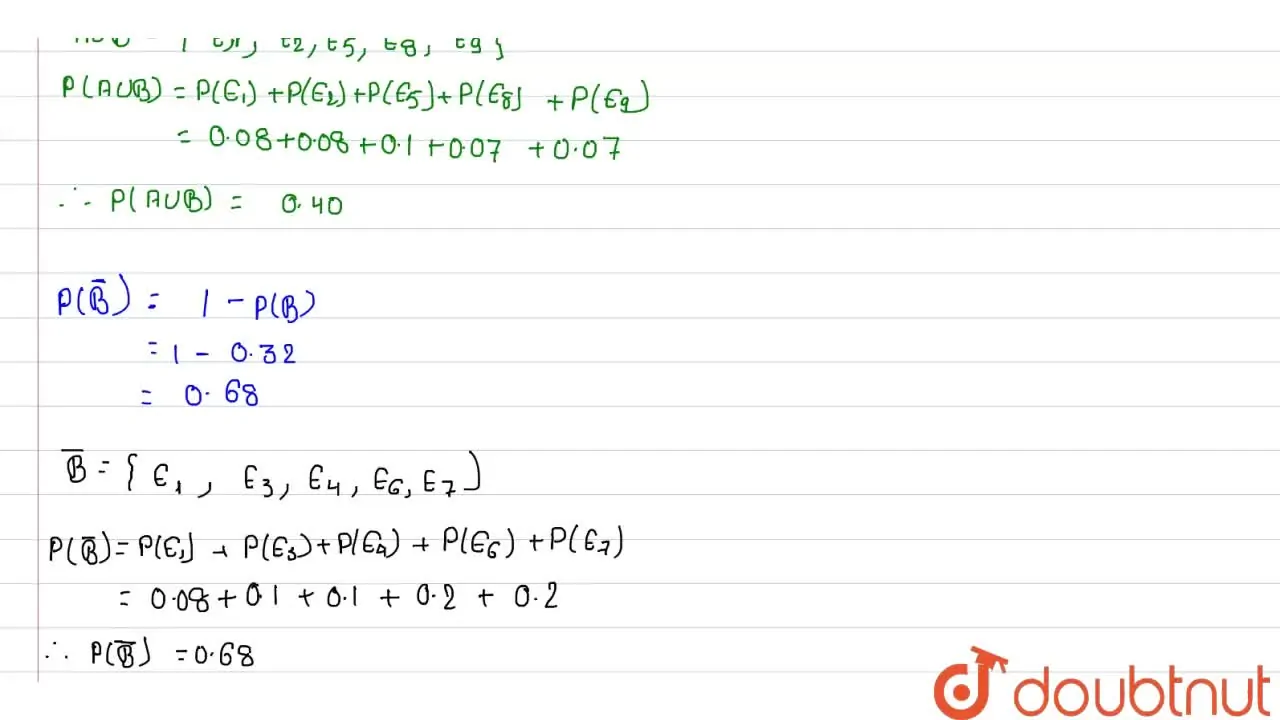A sample space consists of 9 elementary event E1,E2,E3.....E8,E9 whose probabilities are P(E1)=P(E2)=0.08 ,P(E3)=P(E4)=P(E5)=0.1, P(E6)=P(E7)=0.2 ,P(E8)=P(E9)=0.07. Suppose A={E1,E5,E8}, B={E2,E5,E8,E9}. Compute P(A), P(B) and P(A∩B). Using the addition law of probability, find P(A∪B). List the composition of the event A∪B, and calculate, P(A∪B) by adding the probabilities of the elementary events. Calculate P(¯¯¯B) from P(B), also calculate P(¯¯¯B) directly from the elementary events of ¯¯¯B.
Here, P(E1)=P(E2)=0.08
P(E3)=P(E4)=0.1
P(E6)=P(E7)=0.2
P(E8)=P(E9)=0.07
First we will calculate P(E5).
As sample space contains events from E1 to E9.
∴P(E1)+P(E2)+P(E3)+P(E4)+P(E5)+P(E6)+P(E7)+P(E8)+P(E9)=1
⇒0.08+0.08+0.1+0.1+P(E5)+0.2+0.2+0.07+0.07=1
⇒0.9+P(E5)=1
⇒P(E5)=0.1
Now, P(A)=P(E1)+P(E5)+P(E8)=0.08+0.1+0.07=0.25
P(B)=P(E2)+P(E5)+P(E8)+P(E9)=0.08+0.1+0.07+0.07=0.32
P(A∩B)=P(E5)+P(E8)=0.1+0.07=0.17
∴P(A∪B)=P(A)+P(B)−P(A∩B)=0.25+0.32−0.17=0.4
Now, A∪B={E1,E2,E5,E8,E9}
∴P(A∪B)=P(E1)+P(E2)+P(E5)+p(E8)+P(E9)=0.08+0.08+0.1+0.07+0.07=0.4
Now, P(¯¯¯B)=1−P(B)=1−0.32=0.68
Also, ¯¯¯B={E1,E3,E4,E6,E7}
∴P(¯¯¯B)=P(E1)+P(E3)+P(E4)+P(E6)+P(E7)=0.08+0.1+0.1+0.2+0.2=0.68
Related Playlists
Similar Questions
A sample space consists of 9 elementary event E1,E2,E3.....E8,E9 whose probabilities are P(E1)=P(E2)=0.08 ,P(E3)=P(E4)=P(E5)=0.1, P(E6)=P(E7)=0.2 ,P(E8)=P(E9)=0.07. Suppose A={E1,E5,E8}, B={E2,E5,E8,E9}. Compute P(A), P(B) and P(A∩B). Using the addition law of probability, find P(A∪B). List the composition of the event A∪B, and calculate, P(A∪B) by adding the probabilities of the elementary events. Calculate P(¯¯¯B) from P(B), also calculate P(¯¯¯B) directly from the elementary events of ¯¯¯B.
View SolutionA sample space consists of 9 elementary outcomes E1,E2,…..,E9 whose probabilities are
P(E1)=P(E2)=0.08,P(E3)=P(E4)=P(E5)=0.1
P(E6)=P(E1)=0.2,P(E8)=P(E9)=0.07
Suppose A={E1,E5,E8},B={E2,E5,E8,E9}
(i) Calculate P(A), P(B) and P(A∩B).
(ii) Using the addition law of probability, calculate P(A∪B).
(iii) List the composition of the event A∪B and calculate P(A∪B) by adding the probabilities of the elementary outcomes.
Calculate P(−B) from P(B), also calculate P(−B) directly from the elementary outcomes of −B,View SolutionIf P(E)=0.08, What is the probability of not E.
View SolutionIf P(E)=0.05, what is the probability of not E?
View SolutionIf P(E)=0.25, What is the probability of not E.
View SolutionIf P(E)=0.59, find P(not E).
View SolutionIf P(E)=0.05 , then P(¬ E)=
(a)−0.05 (b) 0.5
(c) 0.9
(d) 0.95View SolutionIf P(E) = 0.34, find p(not E).
View SolutionGiven that E and F are events such that P(E)=0.6, P(F)=0.6, P(F)=0.3and P(E∩F)=0.2, find P(E∣F)and P(F∣E).
View SolutionIf the probability of an event E happening is 0.023, then P(¯¯¯E)=______
View Solution


